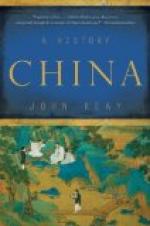This ineffective disarmament was undoubtedly the most pregnant event of the period of the western Chin dynasty. The measure was intended to save the cost of maintaining the soldiers and to bring them back to the land as peasants (and taxpayers); but the discharged men were not given land by the government. The disarmament achieved nothing, not even the desired increase in the money in circulation; what did happen was that the central government lost all practical power, while the military strength both of the dangerous princes within the country and also of the frontier people was increased. The results of these mistaken measures became evident at once and compelled the government to arm anew.
2 Effect on the frontier peoples
Four groups of frontier peoples drew more or less advantage from the demobilization law—the people of the Toba, the Tibetans, and the Hsien-pi in the north, and the nineteen tribes of the Hsiung-nu within the frontiers of the empire. In the course of time all sorts of complicated relations developed among those ascending peoples as well as between them and the Chinese.
The Toba (T’o-pa) formed a small group in the north of the present province of Shansi, north of the city of Tat’ungfu, and they were about to develop their small state. They were primarily of Turkish origin, but had absorbed many tribes of the older Hsiung-nu and the Hsien-pi. In considering the ethnical relationships of all these northern peoples we must rid ourselves of our present-day notions of national unity. Among the Toba there were many Turkish tribes, but also Mongols, and probably a Tungus tribe, as well as perhaps others whom we cannot yet analyse. These tribes may even have spoken different languages, much as later not only Mongol but also Turkish was spoken in the Mongol empire. The political units they formed were tribal unions, not national states.
Such a union or federation can be conceived of, structurally, as a cone. At the top point of the cone there was the person of the ruler of the federation. He was a member of the leading family or clan of the leading tribe (the two top layers of the cone). If we speak of the Toba as of Turkish stock, we mean that according to our present knowledge, this leading tribe (a) spoke a language belonging to the Turkish language family and (b) exhibited a pattern of culture which belonged to the type called above in Chapter One as “North-western Culture”.




